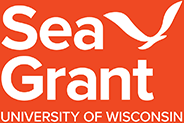Discovery of the Problem and Early Work
In the mid 1990’s, it was determined that the steel sheet piling in the Duluth-Superior Harbor was corroding at an accelerated rate. Based on observations of both older and new sheet pile installations, the increased rate of corrosion appears to have begun in the late 1970s. Underwater inspections revealed the corrosion is widespread throughout the harbor on all types of steel piling buttressing the docks. Most of the steel is riddled with small pits, scooped out in diameters of ¼ to 1 inch, primarily in the first 4 to 6 feet below the waterline and tapering off around 10 feet. Some of the steel beams supporting the dock structures have large holes in them (these have already been or are in the process of being repaired).
It was determined that much of the more than 13 miles of steel sheet piling and structures were corroding around the harbor. If the problem remained unaddressed, the structural integrity of docks and loading facilities could be compromised and the failing steel would have to be replaced at a cost of $1,500 or more per lineal foot. The Duluth Seaway Port Authority estimated there could be $90 to 100 million of possible repairs due to corrosion-weakened steel.
A detailed scientific study was initiated to determine the cause of the accelerated corrosion, to find potential solutions and to investigate if this problem was found at other Great Lakes ports and harbors.
To provide a systematic focus for research and mitigation, a steering committee was formed by the Wisconsin and Minnesota Sea Grant programs, the Duluth Seaway Port Authority, the U.S. Army Corps of Engineers, and the University of Minnesota-Duluth and its Natural Resources Research Institute. The committee recommended that the corrosion problem be reviewed by an independent group of experts.
In September 2004, a panel of five experts visited the harbor to make early assessments. The members included:
Alfred D. Beitelman
Materials Research Engineer
U.S. Army Corps of Engineers
expertise: protective coatings
Rudolph G. Buchheit
Proefessor, Materials Science and Engineering
The Ohio State University
expertise: metallurgy and corrosion
James Bushman
President
Bushman & Associates, Inc.
expertise: electrically induced corrosion
Brenda J. Little
Ocean Sciences Branch
Naval Research Laboratory
expertise: microbiologically influenced corrosion
Charles P. Marsh
Materials Research Engineer
U.S. Army Corps of Engineers
expertise: Great Lakes corrosion
Panel members spent one day visiting areas of the port where accelerated corrosion was particularly apparent, and the next day they met to discuss their observations and review information gathered by the steering committee.
The panel said definitive conclusions about the causes and appropriate actions to mitigate the corrosion would require data gathered through formal measurement, testing, and engineering analysis. The experts narrowed down the initial list of 12 possible causes (all are described in the panel’s final report) to a few likely causes and made both long- and short-term recommendations.
Most Recent Research Finding: Possible Corrosion Mechanism Identified
Long-awaited research findings identify one possible mechanism responsible for accelerated steel corrosion in the Duluth-Superior harbor. The peer-reviewed paper published in the November 2009 CORROSION, The Journal of Science and Engineering, outlines a study led by Brenda Little, Senior Scientist, Marine Molecular Processes, Naval Research Laboratory, Stennis Space Center. Entitled “Factors Contributing to Corrosion of Steel Pilings in Duluth-Superior Harbor” (by R. Ray, J. Lee and B. Little). The research demonstrates a specific sequence of biological, chemical and physical events responsible for localized corrosion of carbon steel piling – including the role ice scour plays in accelerating that process.
Little’s findings confirm that ongoing repair and mitigation studies in the local harbor are on the right track. In layman’s terms, conclusions of this study describe the process by which specific iron-oxidizing bacteria attach to carbon steel, creating a “nodule” of biomass and corrosion products. Conditions beneath those nodules, known as tubercles, cause copper dissolved in harbor water to precipitate and adhere to the iron. When ice chunks scrape against those pilings each winter, the tubercles break, exposing the copper-covered iron to oxygen which, in turn, causes the steel in those pitted areas to corrode at a faster rate.
Microbiologically Influenced Corrosion (MIC) Investigation
The findings from 2006-07 microbiologically influenced corrosion (MIC) research from Dr. Randall Hicks at the University of Minnesota Duluth demonstrate that bacterial communities on the corroded steel in the most affected part of the harbor are different from bacterial communities on these structures at a less-affected area just outside the harbor.
A bacterium that oxides iron (from Fe2+ to Fe3+) was isolated from the corroding structures has been discovered through DNA analysis. Sequencing the 16S rDNA gene of bacterial clones indicated that the majority of bacteria on the surfaces of steel pilings at the corroded sites examined were from three bacterial phyla, the β- and α- Proteobacteria, and Cyanobacteria. This clonal analysis also indicated the presence of a bacterium most similar to an iron-reducing bacterium (Rhodoferax ferrireducens), which can grow well at the low temperatures (4°C) seasonally encountered in this harbor.
Corroding steel structures in the harbor are covered by complex microbial biofilms that contain bacteria of the type responsible for corrosion of steel in other environments. While data from the field leads researchers to theorize MIC may be responsible for the accelerated corrosion seen in this harbor, they lack conclusive evidence that S. lithoautotrophicus nor any other bacterium isolated or found in the clone library so far are responsible for this corrosion.
Research is ongoing and is being done in collaboration with scientists and engineers from the Duluth Seaway Port Authority, AMI Consulting Engineers, the U.S. Naval Research Laboratory-Stennis Space Center, and the U.S. Army Corps of Engineers.
2008 – 09 Studies
Two new State of Wisconsin grants of $130,000 and an additional $280,000 from the federal Water Resources Development Act through the U.S. Army Corps of Engineers funded several new corrosion studies in 2008 – 09. The Wisconsin grants break down as: $100,000 from the Wisconsin Legislature and $30,000 from the Wisconsin Coastal Management Program.
Plus, several new or continuation of existing tests were undertaken:
1. Additional Coupon Sample Collection
Focused on the continued collection of coupons from several coupon trays already in place throughout the harbor. Both uncoated and coated coupons were removed for inspection and additional lab tests.
2. Linear Polarization Tests
Linear polarization testing (LPR) was conducted for 12 to 14 locations (minimum of two cycles each) to estimate instantaneous corrosion rates at different locations throughout the harbor.
3. DC Current Tests
A high voltage DC current test was conducted with measurements taken at eight locations in the harbor. This test investigated the possible effects of the high voltage DC power line that terminates in the region.
4. Hydro Coating Tests
This test investigated a new technology using diver-applied coatings to existing underwater steel structures. This technology could eliminate the need for the traditional cofferdams used to dewater the sheets before coatings could be applied in the dry.
5. In Place Coating Tests – Ice Zone Focus
This small-scale test placed coated steel sheets to test how the coatings stand up to the severe ice action in the harbor.
6. In Place Coating Tests – Review of Existing Coatings in Place
Study documented coating history and included diver inspections of the existing coated sheets already in place throughout the harbor. These coated steel structures were placed before the current corrosion study was initiated and evaluation of these locations served as companion tests to coating trials.
7. In Place Coating Tests – New Coated Sheets
This study included full-scale testing of coating existing steel structures at Superior Entry and Harbor Assistance Grant locations. This work tested the applicability of the use of cofferdams as a base case method for cleaning and coating existing steel already in place but not damaged beyond repair.
8. Perforated Dock Repair Tests
This investigation tested possible repair methods for structures that have corrosion so severe the steel is perforated.
9. Alternative Technology Tests
These investigations explored many alternative corrosion-control methods such wraps and jackets for pile structures, jackets and plates for sheet pile structures, and anodes for both types of structures.
10. Additional Coupon Trays
Additional coupon trays were added at new harbor locations such as upstream in the Nemadji River and at the upstream dam in the St Louis River.
11. Continued Bulk Chemistry Tests
Additional bulk water chemistry samples and associated testing compared changes of water chemistry with those samples collected in 2006.
12. Continued MIC Testing
Microbiologically Influenced Corrosion (MIC) testing continued to investigate the role MIC may have in the accelerated corrosion process.
2006-07 Research
The majority of 2007 field work completed consisted of collecting existing coupons from the trays installed in 2006 and the installation of eight new trays. Several coupon samples were collected from the Hallet Dock coupon tray (installed in 2006), visually inspected and then sent to labs for further corrosion project analyses. The eight new trays contained four uncoated and four coated coupons each. The work was completed by AMI Consulting Engineers.
In 2006, separate contacts were let to separate out the investigations of the federal and the nonfederal structure locations. Both involved water and structural assessments.



